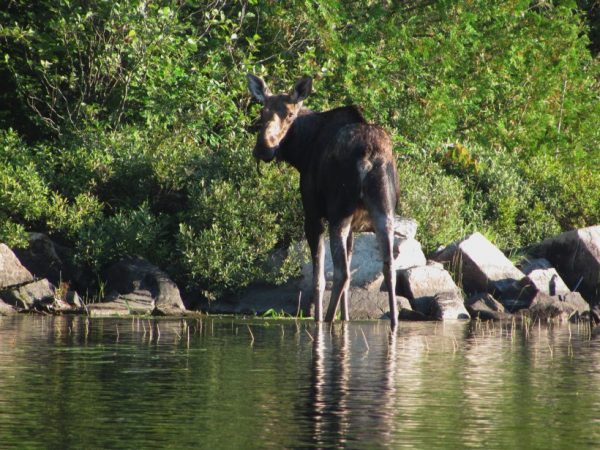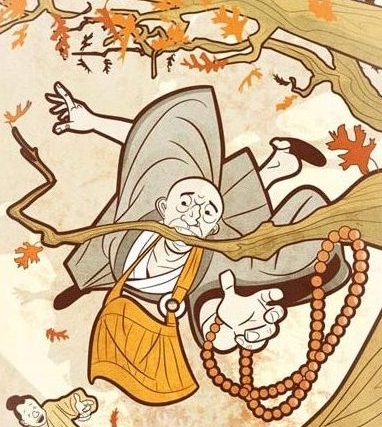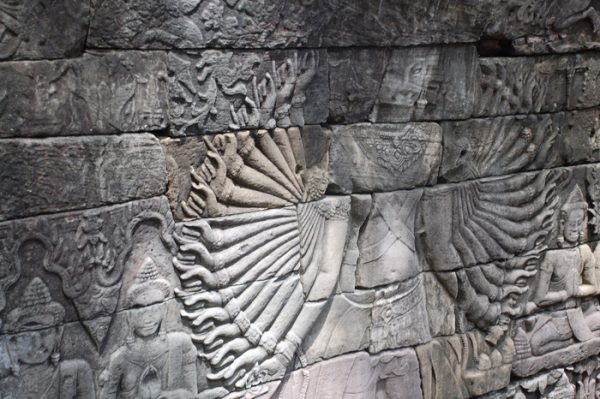When the Master was about to die, the head monk asked him, “Your Reverence, a hundred years from now where will you be?” “I shall be a water buffalo at the foot of the hill,” said the Master. “Will it be alright for me to follow you?” asked the head monk. “If you follow me, you must hold a stalk of grass in your mouth,” was Puyuan’s reply.
Puyuan is Nanquan Puyuan. This encounter appears in the Entangling Vines or the Shumon Kattoshu, in the biographical sketch on Nanquan. I find the monk’s question rather curious, why is he asking the Master where he will be a hundred years after his death? Perhaps the question is just what it appears to be, the monk simply wants to learn what the Master believes will happen after death. Nanquan’s response is even more curious. “I shall be a water buffalo at the foot of the hill.” Is he answering the monk’s question as to where he will be long after his death?
The water buffalo actually appears in another dialogue involving Nanquan , this time with his student Chao-chou. This appears in the collection known as the Transmission of the Lamp, which are the encounters between teacher and student where the student’s enlightenment is acknowledged and the Dharma is transmitted.
One day Chao-chou asked, “Where should he take rest who knows that he has it?” Nan-ch’uan replied, “He should become a buffalo at the foot of the mountain.” Chao-chou thanked him for this instruction, and Nan-quan remarked, “In the middle of last night the moon appeared at the window.”
Clearly Nanquan has a deep appreciation for water buffalo. “He should become a buffalo at the foot of the mountain.” “I shall be a water buffalo at the foot of the hill.” Why water buffalo?
I don’t know a lot about water buffalo, beyond what I have seen in images of south Asia, the buffalo standing immersed in a river or a rice paddy, calmly inhaling aquatic plants. I wonder if Nanquan lived here in Maine, instead of a buffalo, he would be talking about a moose? The passerby in a cool northern bog is startled momentarily as a great head rises from the water. Water pours from the jowls, the mouth full of green matter extracted from below the surface. It turns slowly and glances at the foreign shape gliding by. Then, convinced that there is no threat, it resumes slowly masticating of its meal. Huge and majestic, yet deliberate and calm.
What is the great moose reflecting on as it stands there? Does it ponder some great existential dilemma? “Why am I here?” “What is the meaning of life?” Does it dwell on its impermanence, wondering how long it will live and how it will die. Does it even reflect at all on this encounter with this strange being floating by?
When it wakened this morning, did the moose think to itself, “I screw everything up, I’m a lousy moose.” Or, “my belly is getting too large, maybe I should cut back on the duckweed.”
Is this moose aware of any moment other than this one, as it wades along the bog’s edge in search of its next mouthful? Does it have an agenda for today which demands that it hurry up and move along? Or, does it simply chew, perhaps enjoying the taste of its meal and the growing fullness in its belly and nothing more? If this moose could respond to these questions, would it answer, “When I eat, I eat. When I sleep, I sleep.”
Like the water buffalo, this moose is most often found at the foot of the mountain. It does not dwell on the heights, although it sometimes visits there. It does not remain stuck in a view of the endless expanse of sky and the vast landscape unfolding below. It returns to the bog each day at dawn and dusk, attending to the simple, repetitive task of replenishing itself, while harboring no great pretentions and no illusion of grandeur. We could say that this is then is moose mind.
In this mind of moose there is no separation. The moose, the water, the plants, the surrounding hills, the northern sky, there is no distinction. The young moose is threatened, the mother moose responds. The threat and response are inseparable. Not one, not two.
“Where should he take rest who knows he has it?” “He should become a moose at the foot of the mountain.”
How do we humans find this moose mind, after all our lives are so complex? We have so very many thoughts arising in endless succession. Should we forsake our lives, our families, or jobs, our comfortable homes and go off into the mountains to live a life of utter simplicity that would make Thoreau’s life on Walden Pond look opulent by comparison?
Even if we did that, we could not shed our nature as thinking beings. That is what it means to be human and we are all terminally human. We don’t need to go away, abandoning our lives to be more like the moose and to see what Nanquan saw. What we need to do is release our attachment to holding ourselves apart, as solid, separate entities. We need to immerse ourselves completely in our lives. We need to be intimate in all of our relationships; with our families, our work, and with the world. In those relationships we need to take very good care of everything we encounter. We must treat it all like it is irreplaceable, for in truth it is. Then, like the mother moose responding to defend her young, we simply respond from that place of deep connection, of non-separation.
There is no thought of “how will this action affect me”. “Will I gain from this.” “Will this person like me if I do this?” “Oh my God, what do they expect of me.” “How can I endure this any longer.” “Those bastards, they don’t care about me.”
This understanding of Nanquan’s is further revealed in yet another koan.
Nanquan said to the assembly, “The buddhas of past present and future do not know it is: cats and cows know it is.”
Wansong gives us a wonderful introduction to this koan: Becoming a Buddha and being a Patriarch is disliked for wearing a deflied name; wearing horns and fur is pushed to the superior position. This is why “the true light doesn’t shine, great wisdom appears foolish.” There is yet another who is deaf for convenience and pretends not to be skillful—do we know who he is?
So cats, cows, buffalo, even moose (and of course dogs) know it is, while the buddhas of past present and future do not. That is because they are just cats, cows, buffalo, moose and dogs, nothing more. They are not zen students or zen teachers. They are not spiritual persons. They do not live by the precepts. They are not Buddhas or Bodhisattvas.
Now to the matter of Nanquan’s death. At daybreak on the morning of the 27th of January, 835, the Master said to his disciples, “The star has been fading and the lamp growing dim for a long time. Do not say that I came or went.” His words ceased, and he passed away. He was in his eighty-seventh year.
From the perspective of the mind that Nanquan is pointing to in these koans, there is no one, no thing that lives or dies. Nanquan did not come or go. In his life the water buffalo stood grazing at the foot of the mountain. After his death, the water buffalo stood grazing at the foot of the mountain.



